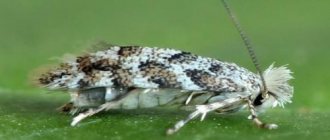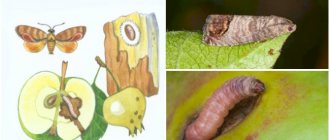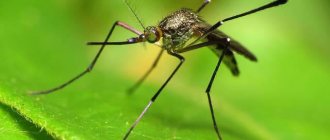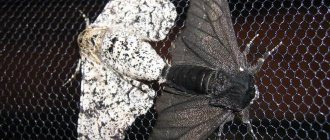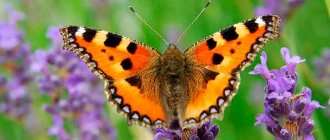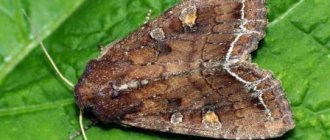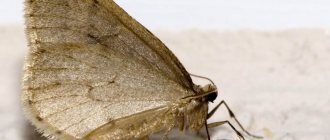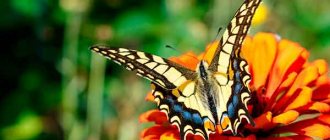- Wild animals
- >>
- Insects
Pied butterflies are a large family of motley butterflies, including over a thousand species and distributed throughout the planet except for permafrost lands. The moth butterfly has a calm character, even their flight itself seems sleepy and lazy - they are poisonous and have almost no fear of predators. They often become garden pests.
Origin of the species and description
Photo: Pied Butterfly
The first butterflies appeared about 140 million years ago - there are well-preserved fossils found in amber, so their appearance is reliably established. Unfortunately, fossilized remains of butterflies are relatively rare to find because their bodies are delicate and poorly preserved.
Therefore, scientists believe that butterflies may actually be older than the oldest fossils found, and it is likely that they appeared 200-250 million years ago. Their flourishing is associated with flowering plants - as they spread across the planet, butterflies became more and more numerous.
Flowers became the main source of food, and to obtain nectar, butterflies acquired a proboscis and beautiful wings to resemble flowers. The first to appear were the nocturnal (even-whiskered) butterflies, and only then the diurnal (even-whiskered) butterflies appeared. The division into diurnal and nocturnal is quite arbitrary - for example, the moth is a nocturnal moth, but most of its species lead a diurnal lifestyle.
Video: Butterfly
Therefore, the key parameter is still the mustache. Variegated butterflies appeared first, and for the most part they are smaller and more primitive in structure. This partly applies to the moth - it has rather simple wings, which is why it flies slowly and clumsily, but still surpasses almost any moth in both size and complexity of its structure.
This suggests that pied moths originated relatively recently, although the details of their origin are unknown to researchers: this is due to the small number of finds of fossil butterflies. As for the moths themselves, this is a large family that includes over 1,000 species, and new ones are still being discovered periodically.
Its scientific description was made by Pierre Andre Latreille in 1809, at which time the name was given in Latin - Zygaenidae. The genera and species included in the family are very diverse, so that it is sometimes difficult to understand, just by looking at butterflies of different species, that they are closely related.
Appearance and features
Photo: Poisonous moth butterfly
The body relative to the wings of most members of the family is large, as a result of which they look far from being as fragile and graceful as other butterflies. It affects the fact that they belong to different-winged butterflies, which differ in structure from the usual daytime butterflies. The body is also studded with bristles.
The wingspan varies significantly depending on the species, ranging from 15 to 60 mm - thus, pests belong to small or medium-sized butterflies. They can have a proboscis either well developed or greatly reduced. There are no scales on it. The palps, both maxillary and labial, are short in pests.
The antennae can be different, in any case they thicken towards the end, that is, they are club-shaped. Pelts also have chitozema - these are bristles located on the head, playing the role of a sensory organ.
Most of the representatives of the family are distinguished by their very bright colors that catch the eye - this is even reflected in the name. The main color of the wings is usually black, blue or green, and they are often dotted with spots - yellow, orange or red. It is rare to find moths that are monochromatic or close to this, as well as simply pale ones.
They have bright colors for a reason; this is a signal to predators that the butterfly is dangerous for them - the fact is that pests are poisonous, toxins accumulate in their bodies, especially hydrocyanic acid. Many predators who eat the pest will be poisoned - in the best case, they will have to suffer a lot, even death is possible.
This butterfly also has another method of defense: if it is disturbed, it can secrete an odorous liquid containing poison. Not only adult butterflies are poisonous, but caterpillars too.
Description of pests
The size of eggs of pests is 0.4-0.6 millimeters. The shape is oblong. The color is yellow with a characteristic mesh pattern. The eggs of some species of pests are covered with scales.
Many pied caterpillars secrete protective secretions - products of amino acid metabolism. Viscous secretions are stored in special cavities located in the cuticle.
Adult moths are small to medium in size. The wingspan averages 4 centimeters.
An exception is the species Elcysma westwoodii; the wingspan of these butterflies is approximately 6 centimeters.
The proboscis of pests is long, well developed, without scales. But in some species the proboscis is reduced. There are short labial and maxillary palps. The antennae on the head may be serrated, comb-like, or fusiform. The color of the antennae is green or blue with a metallic sheen. When at rest, butterflies fold their wings like a roof.
Where does the moth butterfly live?
Photo: Pied butterfly in Russia
Representatives of the family are distributed almost throughout the entire planet except for the coldest corners, where butterflies simply cannot live. Of course, different species have their own habitats; the following main zones of distribution of subfamilies are distinguished:
- Zygaeninae live throughout almost all of Europe and Asia, as well as in northeastern Africa;
- Chalcosiinae prefer the southeast of Asia; outside it they can also be found, but relatively rarely and only a few species;
- Procridinae are found almost everywhere, although with unequal frequency - the largest number of species, as well as the populations of the butterflies themselves, live in the tropics;
- Phaudinae, as well as Callizygaeninae, are relatively rare subfamilies and include a small number of species; they can only be found in the Indian region and Southeast Asia.
In general, moths love warm climates and are most common in the tropics and subtropics. The temperate climate is much poorer in these butterflies, but it also has its own unique species. Pied moths also prefer moist air, which is why there are much more of them in the zone adjacent to the sea within 1,000 kilometers from the coast than in the interior of the continent.
They settle in places rich in vegetation, where it is convenient for them to feed themselves and lay eggs, that is, flowers and food plants grow close to each other. Often this is a meadow or garden - they are known as garden pests, because they live in large groups and can literally eat some plants.
What does the moth butterfly eat?
Photo: Spotted butterfly from the Red Book
Adult butterflies consume mainly nectar and do not cause any harm. Preferences can vary greatly depending on the species, but in temperate latitudes it is usually meadow and garden flowers.
Such as:
- clover;
- bell;
- dandelion;
- aster;
- narcissus;
- cornflower;
- gentian;
- blooming Sally;
- crocus;
- buttercup.
Some moths may also drink the sap of trees or rotting fruit. In any case, in the form of imagoes they do not interfere with people in any way, the only problem is the caterpillars - it is because of them that if such butterflies appear in the garden, they must be urgently exterminated. There can be a lot of caterpillars, and they often feed on the leaves and buds of garden trees and bushes.
The following may be subject to their attacks:
- grape;
- plum;
- pear;
- cherry;
- Apple tree;
- sorrel;
- peas;
- legumes
These butterflies do not fly far, and if they have already appeared in your garden, a whole population of them may soon emerge, and the trees will not be able to survive from the caterpillars - there may be several hundred of them on one, which will greatly reduce its fertility.
Interesting fact: The body of many moths is covered with hairs to scatter the signal of bats - with its help they find insects and then catch them, but catching moths is not so easy. Some also have ears that are sensitive to ultrasound and, hearing that a bat is nearby, the butterfly falls to the ground and avoids meeting it. There are even some that emit a response signal, confusing the bat.
Damage caused
The pests cause great damage, causing crop losses, in the spring. The caterpillars of these butterflies eat the buds when they begin to swell. The mass reproduction of pied moths is focal in nature, since these butterflies almost never fly over long distances.
Most often, harm to gardening is caused by the apple silver moth, which damages apple trees, pears and dogwoods.
Despite their beautiful appearance, pests are considered pests, as the caterpillars eat tree buds.
Also harmful is the white-spotted pocket moth, which causes damage to plum, pear, cherry plum, rowan and cherry. The leaf miner moth can lead to large yield losses.
If you find an error, please select a piece of text and press Ctrl+Enter.
Features of character and lifestyle
Photo: Pied Butterfly
Most moths fly actively during the day and rest at night. Although there are exceptions - some species fly at night, like other moths, they tend to fly towards lanterns and into illuminated windows. Most often, moths love sunlight and warmth; they can often be seen basking in the rays, with their wings folded.
The design of their wings is quite primitive - this is due to the fact that they are not usually hunted in the air, and therefore pied moths did not have as many incentives to improve their wings as most other butterflies. As a result, they fly very slowly and their flight looks clumsy.
A caught moth may pretend to be dead. The level of fearfulness varies depending on the species - some pieds, until obvious aggression is shown towards them, are generally calm, allow people to freely take control of themselves and do not even try to fly away.
Such a calm character was largely developed due to the fact that they are threatened by quite a few dangers, and there is no need to be afraid of every rustle - an ordinary butterfly cannot afford such calmness, because every minute, even right in flight, birds can hunt for it .
The life of pests is calm and measured: when the sun comes out, they fly out to feed on flowering plants, slowly flying from one to another, usually close to other pests, in whole groups. In general, they are not inclined to move far and can spend their entire lives in one garden or in one meadow.
Social structure and reproduction
Photo: Pair of pied butterflies
Eggs are laid in the spring. The masonry can be either single or in rows. The eggs are about half a millimeter in size, they are elongated and yellow in color. It takes the caterpillar about a week and a half to hatch.
She has a kind of protection - she can pull her head into her chest. Her entire body is also protected: it is covered with bristles. But much more important is that it is poisonous, which is why rare predators risk attacking it; most know very well that it is inedible.
Having properly eaten and grown, the caterpillar goes to “winter.” This can be called this very conditionally, because wintering for them can begin in July, if these are caterpillars of the first generation, the earliest, or in August for subsequent generations. This is in temperate latitudes; in the tropics, new generations appear all year round.
They spend a lot of time hibernating until the next warm period. Then they wake up and again begin to devour leaves or buds, because it takes a lot of energy to turn into a butterfly. Having accumulated enough reserves, they finally pupate and then develop into adults.
Thus, more than a year passes from laying an egg to becoming an adult. The butterfly usually does not fly far, and reproduces in the same garden where it appeared - as a result, if measures are not taken against them in time, within a year the garden may be literally filled with them, which will not benefit its fertility at all.
Natural enemies of moths
Photo: Pied butterfly in nature
Due to the poisonous nature of the pest, the pest has relatively few enemies, both in the form of a caterpillar and after transformation into an adult. Most predators are repelled by its color or the smell of the substance that it releases when it is in danger - both of which indicate inedibility.
But still, some predators can digest such butterflies and hunt them. The list of enemies of the pest can vary greatly depending on what species it belongs to, but most often it includes:
- ground beetles;
- coccinellides;
- spiders;
- predatory bugs;
- syrphid fly larvae.
Those listed above are not afraid of the poison of the moth, but they most often hunt for its eggs and caterpillars, and the imago can feel safe - only large tropical spiders can threaten it.
An important enemy of pied moths, most likely even the worst, is people. Due to the fact that pests are garden pests, and very malicious ones, they are purposefully fought with the help of chemicals, which destroys large numbers of them, and sometimes even entire populations.
Interesting fact: There are also false pests - it is very easy to confuse the real ones with them due to their external resemblance. Moreover, they belong to different families - the false pestle belongs to the Erebidae, but leads the same way of life as the real pestle, and can even be found in the same fields. There are a lot of species of false pestle - about 3,000.
Ways to combat pestra
In agriculture, the following scheme for controlling pests, which involves the use of chemicals, is considered optimal:
- When the buds swell, the trees are sprayed with the insecticide DDT (dichlorodiphenyl trichloromethylmethane) at a 5.5% concentration or hexachlorane (12%).
- After bud break, these drugs are reused.
- In mid-summer, when new caterpillars have emerged from the eggs, only DDT is applied. To ensure that the crop is safe for consumption, the procedure can only be carried out 30 (or more) days before harvesting.
The use of biologically active drugs will also be effective: for example, Entobacterin and Dendrobacillin. If the air temperature is less than 25 °C, then they must be used in combination with pesticides. For example, with products containing organophosphorus components.
Natural enemies of pied moths: spiders, ground beetles, predatory bugs, larvae of hoverflies (lat. Syrphidae).
Speckles are a dangerous enemy of the garden and vegetable garden. They spread very quickly throughout the area because they prefer not to fly far from their habitat. The use of chemical and biological drugs, which must be used in accordance with the scheme and safety rules, will help drive them out.
Population and species status
Photo: Pied butterfly in Russia
In general, nothing threatens pied moths as a family - they reproduce rapidly, and where a couple of butterflies live, a few years later there may be a thousand. Even fighting them does not always help to completely get rid of these pests, but often only reduces their population to acceptable levels.
Thus, due to rapid reproduction, these butterflies are very tenacious. But there is another nuance - they do not spread evenly over a large area, but live in pockets, very densely. As a result, the complete destruction of several such foci can greatly reduce the range of the species, and if it was not widespread, then put it at risk.
Therefore, although many pests are much more widespread than people would like, and there are a lot of them, there are also rare species that are on the verge of extinction and are protected in certain countries or regions.
Interesting fact: There are about 18 thousand species of butterflies, also known as diurnal butterflies. This may seem like a lot, but there are many more different species - about 150 thousand species. Most often, moths are small in size and have a primitive structure, but the species diversity among them is amazing.
So, along with very small moths, these include Saturnia pear and Death's head hawk moth - their wingspan can exceed 150 mm. There are much more moths not only in the number of species, but also simply in quantity, and at night a simply huge number of lepidopterans lead their lives.
Zygaena filipendulae (Linnaeus, 1758)
System
class Insecta → subclass Pterygota → infraclass Neoptera → superorder Holometabola → order Lepidoptera → superfamily Zygaenoidea → family Zygaenidae → subfamily Zygaeninae → genus Zygaena → subgenus Zygaena → species Zygaena filipendulae
Full title
Zygaena (Zygaena) filipendulae (Linnaeus, 1758) = Sphinx filipendulae Linnaeus, 1758 = Adscita aries Retzius, 1783 = Sphinx chrysanthemi Borkhausen, 1789 = Sphinx lavandulae Hübner, 1790 = Sphinx stoechadis Borkhausen, 1793 = Shinx filip endulae major Esper, 1794 = Sphinx medicaginis Hübner, 1796 = Sphinx cytisi Hübner, 1796 = Zygaena charon Boisduval, 1834 = Zygaena ochsenheimeri Zeller, 1847 = Zygaena ramburii Herrich-Schäffer, 1861 = Zygaena mersina Herrich-Schäffer, 1861 = Zygaena gurda Lederer, 1 861 = Zygaena syriaca Oberthür, 1896 = Zygaena rosa Oberthür, 1909 = Zygaena (Zygaena) filipendulae = Anthrocera filipendulae.
Meadowsweet moth, meadowsweet moth, common meadowsweet
urn:lsid:insecta.pro:taxonomy:11834
Spreading
Zoogeographical areas
Palaearctic.
Regions of Russia
#1. Kaliningrad; #4. European Northwestern; #7. European southern taiga; #8. European Central; #9. European Central Black Earth; #10. Middle Volga; #eleven. Volgo-Don; #13. West Caucasian; #14. East Caucasian.
Front fender length
18-20 mm.
Primary colors
Red, Green, Brown/Grey/Black.
Summer time
| January | February | March | April | May | June | July | August | September | October | November | December |
Lifetime of the larva
| January | February | March | April | May | June | July | August | September | October | November | December |
Detailed information indicating sources
Synonyms and generic combinations
- Anthrocera filipendulae [11]. Peter Khramov.
Features of appearance and differences from similar species
- The length of the front wing is exactly 2 cm. On the black or greenish background of each of the front wings there are 6 red spots. In contrast to Zygaena trifolii, which has only 5 of them. [5]. Peter Khramov.
- The forewings are metallic green or bluish, with five red spots. The hind wings are bright red. The antennae are thickened towards the end, and pointed at the very edge. The abdomen is thick. [eleven]. Peter Khramov.
Spreading
- Austria, Belgium, Bulgaria, Great Britain, Hungary, Germany, Greece, Denmark, Ireland, Spain, Italy, Latvia, Lithuania, Luxembourg, the Netherlands, Norway, Poland, Romania, Sicily, Slovakia, USSR - European part, Turkey - European part, Finland, France, Czech Republic, Switzerland, Sweden, Estonia, Yugoslavia. [1]. Peter Khramov.
- Regions of the Russian Federation: Volga-Don, East Caucasus, European North-West, European Central Black Earth, European Central, European South Taiga, West Caucasus, Kaliningrad, Middle Volga. [3]. Peter Khramov.
- Austria, Albania, Andorra, Belarus, Belgium, Bulgaria, Bosnia and Herzegovina, British Isles, Vatican City, Hungary, Germany, Greece (Mainland), Denmark (Mainland), Ireland, Spain (Mainland), Italy (Mainland) , Latvia, Lithuania, Liechtenstein, Luxembourg, Macedonia, Moldova, Monaco, the Netherlands, Norway (mainland), Channel Islands, Poland, Russia, Romania, San Marino, Northern Ireland, Sicily, Slovakia, Slovenia, Turkey (European part) , Ukraine, Finland, France (mainland), Croatia, Czech Republic, Switzerland, Sweden, Estonia, Yugoslavia. [10]. Peter Khramov.
- Europe to 61° north w. In the mountains up to 2000 m. [5]. Peter Khramov.
Summer time
- July August. [5]. Peter Khramov.
Additional information about the adult stage
- Meadowsweet moths are daytime inhabitants of dry lawns, marshy areas and heaths. [5]. Peter Khramov.
- If the butterflies are caught, they pretend to be dead and secrete droplets of a thick yellow liquid with a pungent odor. [eleven]. Peter Khramov.
Lifetime of the larva
- August—June. [5]. Peter Khramov.
Food plants or other objects
- Lotus, Dorycnium. [28]. Peter Khramov.
- Little grass (Lotus corniculatus), mountain elm (Coronilla coronata) and other herbs. [5]. Peter Khramov.
- Plantain (Plantago), Elm (Coronílla), Lotus (Lotus), Clover (Trifolium), Horseshoe (Hippocrepis), Oxytropis Personal communication. Vasily Feoktistov.
Additional information about the larva
- Zygaena filipendulae caterpillars are small, greenish-yellow, with small hairs, and build a cocoon on the petiole of a leaf. [5]. Peter Khramov.
- The caterpillars of the moth are thick and clumsy. [eleven]. Peter Khramov.
Subspecies Zygaena filipendulae
- Z. f. anodolitia Reiss, 1929.
- Z. f. europensis Daniel, 1957.
- Z.f. gemina Burgeff, 1914.
- Z.f. helmosica Reiss, 1962.
- Z.f. kulpiensis Reiss, 1935.
- Z.f. mannii Herrich-Schäffer, 1852.
- Z. f. mersina Herrich-Schäffer, 1861.
- Z. f. noacki Reiss, 1962.
- Z. f. noacki Reiss, 1962.
- Z. f. polygalae (Esper, 1783).
- Z. f. Rosa Oberthür, 1909.
- Z. f. Schuberti G. & H. Reiss, 1973.
- Z. f. seeboldi Oberthür, 1910.
- Z. f. stephensi Dupont, 1900.
We worked on the material
Primary addition of the species: Petr Khramov.
Photos: Vlad Proklov.
Text information: Petr Khramov, Vasily Feoktistov.
Formalization of the main features: Petr Khramov.
Formalization of color characteristics: Petr Khramov.
Literature
- [1] O. Karsholt, J. Razowski (eds.), 1996. The Lepidoptera of Europe: a distributional checklist
- [3] Efetov K. A. Zygaenidae. — Catalog of Lepidoptera (Lepidoptera) of Russia. Ed. S. Yu. Sineva. St. Petersburg; M.: Partnership of scientific publications KMK, 2008
- [5] Reichholf-Rim H. Butterflies. M.: Astrel, 2002
- [10] de Jong, YSDM (ed.) (2011) Fauna Europaea version 2.4 (faunaeur.org)
- [11] Animal life according to A.E. Brem. T.2: Arthropods. M.: Uchpedgiz RSFSR, 1941
- [28] Moths and Butterflies of Europe and North Africa (leps.it), 2012
- Vasily Feoktistov, personal message
Comments
Register on the site and/or log into your account to upload new posts and comments
* By default, the site administration is responsible for translating comments from Russian into English. If you want to preserve the author’s style as much as possible or simply make life easier for the translator, copy the text along with tags from the Russian comment window, paste it into the English window and replace the Russian text with English, keeping the tags.
